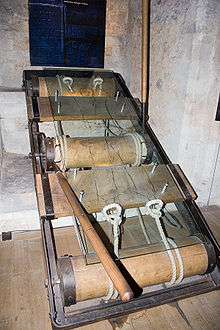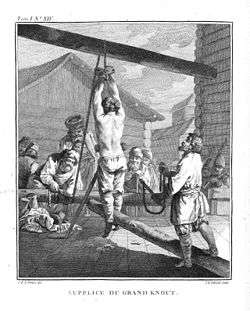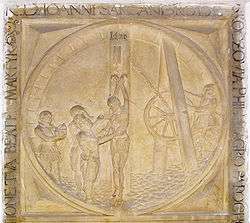Rack (torture)

The rack is a torture device consisting of a rectangular, usually wooden frame, slightly raised from the ground, with a roller at one or both ends. The victim's ankles are fastened to one roller and the wrists are chained to the other. As the interrogation progresses, a handle and ratchet mechanism attached to the top roller are used to very gradually increase the tension on the chains, inducing excruciating pain. By means of pulleys and levers this roller could be rotated on its own axis, thus straining the ropes until the sufferer's joints were dislocated and eventually separated. Additionally, if muscle fibres are stretched excessively, they lose their ability to contract, rendering them ineffective.
One gruesome aspect of being stretched too far on the rack is the loud popping noises made by snapping cartilage, ligaments or bones. One powerful method for putting pressure upon prisoners was to force them to watch someone else being subjected to the rack. Confining the prisoner on the rack enabled further tortures to be simultaneously applied, typically including burning the flanks with hot torches or candles or using pincers made with specially roughened grips to tear out the nails of the fingers and toes. Usually, the victim's shoulders and hips would be separated and their elbows, knees, wrists, and ankles would be dislocated.
Uses

Early use
Arrian's Anabasis of Alexander states that Alexander the Great had the pages who conspired in his assassination, and their mentor, his court historian Callisthenes, tortured on the rack.[1]
According to Tacitus, the rack was used to extract the names of the conspirators to assassinate Emperor Nero in the Pisonian conspiracy from the freedwoman Epicharis in 65 A.D. The next day, after refusing to talk, she was being dragged back to the rack on a chair (all of her limbs were dislocated, so she could not stand), but strangled herself on a loop of cord on the back of the chair on the way.[2]
It was used during antiquity, being used on St. Vincent (304 A.D.) and mentioned by the Church Fathers Tertullian and St. Jerome (420 A.D.).[3]
Medieval Britain
Its first appearance in England is said to have been due to John Holland, 2nd Duke of Exeter, the constable of the Tower in 1447, whence it was popularly known as the Duke of Exeter's daughter.
In 1628 the question of its legality was raised by a proposal in the Privy Council to rack John Felton, the assassin of the Duke of Buckingham. The judges resisted this, unanimously declaring its use to be contrary to the laws of England. The previous year Charles I had authorised the Irish Courts to rack a Catholic priest; this seems to have been the last time the rack was used in Ireland. In 1679 Miles Prance, a silversmith who was being questioned about the murder of the respected magistrate Sir Edmund Berry Godfrey, was threatened with the rack, although it is unlikely that the threat was a serious one.
Guy Fawkes is also thought to have been put to the rack, since a royal warrant authorising his torture survives. The warrant states that the "lesser tortures" should be applied to him first, but that if he remained recalcitrant he could be racked.
France
The French introduced an "improvement" to the rack in the form of spiked rollers that were inserted under the spine of the victim, thus causing even more severe pain and damage.
Inquisition
The Inquisition adopted another method of torture. The sufferer was bound (usually at their wrists) and suspended, lifted slowly and dropped one or more times. This technique provoked fractures of arms and shoulders. It had to last less than half an hour, since keeping victims in such a position for longer periods could lead to death.
Russia

In Russia up to the 18th century the rack (дыба, dyba) was a gallows-like device for suspending the victims (strappado). The suspended victims were whipped with knout and sometimes burned with torches.[4]
Other punitive positioning devices
The term rack is also used, occasionally, for a number of simpler constructions that merely facilitate corporal punishment, after which it may be named specifically, e.g., caning rack, as in a given jurisdiction it was often the custom to administer any given punishment in a specific position, for which the device (with or without fitting shackling and/or padding) would be chosen or specially made.

A similar device was the intestinal crank. This method of torture involved making an incision in the abdominal area, separating the duodenum from the pylorus, and attaching of the upper part of the intestine to a crank. The crank would then be rotated to extract the intestines from the gastrointestinal cavity of a conscious person.[5]
Several devices similar in principle to the rack have been used through the ages. One of these was the Wooden Horse, a device used to torture prisoners during the Roman Empire by stretching them on top of a tall wooden frame until the shoulders were dislocated followed by a violent drop into a hanging position and beating. In another variant used primarily in ancient times, the victim's feet were affixed to the ground and his/her hands were chained to a wheel. When the wheel was turned, the person was stretched in a manner similar to the rack. The Austrian Ladder was basically a more vertically oriented rack. As part of the torture, victims would usually be burned under the arms with candles.
See also
References
- ↑ The Anabasis of Arrian
- ↑ The Annals by Tacitus (Section 15.57)
- ↑ The Letters of St. Jerome, Letter I, to Innocent, ¶ 3
- ↑ Котошихин Г. К. О России, в царствование Алексея Михайловича. Современное сочинение Григория Котошихина. — СПб.: Археографическая комиссия, 1859.
- ↑ "Witchcraft Trials". Ethical Canons and Scientific Inquiry. Archived from the original on December 7, 2011. Retrieved February 28, 2014. (citing Monestier, 1994).
Sources
| Wikimedia Commons has media related to Rack (torture). |
 This article incorporates text from a publication now in the public domain: Chisholm, Hugh, ed. (1911). "article name needed". Encyclopædia Britannica (11th ed.). Cambridge University Press.
This article incorporates text from a publication now in the public domain: Chisholm, Hugh, ed. (1911). "article name needed". Encyclopædia Britannica (11th ed.). Cambridge University Press.- Monestier, M. (1994) Peines de mort. Paris, France: Le Cherche Midi Éditeur.
- Crocker, Harry W.; Triumph: The Power and Glory of the Catholic Church - A 2,000 Year History